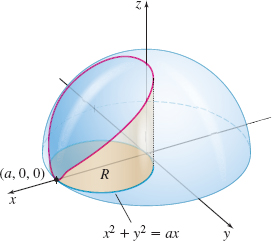EXAMPLE 3Finding Surface Area
Find the surface area of the part of the sphere x2+y2+z2=a2 that lies above the xy-plane and is contained within the cylinder x2+y2=ax, a>0.

Solution Figure 40 shows the sphere and the cylinder. The equation of the surface in explicit form is z=f(x,y)=√a2−x2−y2
The partial derivatives of z =f(x,y) are fx(x,y)=−x√a2−x2−y2fy(x,y)=−y√a2−x2−y2
The projection of the cylinder onto the xy-plane is the region R enclosed by the circle x2+y2=ax, a>0. Then the surface area S that we seek is S=∬
Since the integrand involves the expression x^{2}+y^{2} and the boundary of R is the circle x^{2}+y^{2}=ax, we use polar coordinates (r,\theta). We begin by finding the limits of integration. Since \begin{eqnarray*} x^{2}+y^{2} &=&ax \\ r^{2} &=&ar\cos \theta \\ r &=&a\cos \theta \end{eqnarray*}
we find that r varies from 0 to a\cos \theta.
Since half the area is to the right of the xz-plane and half is to the left of the plane, we can let \theta vary from 0 to \dfrac{\pi }{2} and double the area. Then the surface area S is \begin{array}{rcl} S& =&\int\limits\int_{\kern-11ptR}\sqrt{\dfrac{a^{2}}{a^{2}-x^{2}-y^{2}}}\,d\!A \underset{\underset{{\color{#0066A7}{\hbox {a>0}}}}{\color{#0066A7}{\uparrow }}}{=} \int\limits\int_{\kern-11ptR}\dfrac{a}{\sqrt{a^{2}-r^{2}}} \,r\,dr\,d\theta \underset{\underset{{\color{#0066A7}{\hbox{Double the area}}}}{\color{#0066A7}{\uparrow}}}{=} 2\int_{0}^{\pi /2}\!\!\int_{0}^{a\cos \theta }\dfrac{a}{\sqrt{a^{2}-r^{2}}} \,r\,dr\,d\theta \notag \\ \quad \\ &=&-2a\int_{0}^{\pi /2}\Big[ \sqrt{a^{2}-r^{2}}\Big] _{0}^{a\cos \theta }d\theta =-2a\int_{0}^{\pi /2}(a\sin \theta -a)\,d\theta\\ &=&-2a^{2}\big[-\cos \theta -\theta \big] _{0}^{\pi /2}=a^{2}(\pi -2) \end{array}